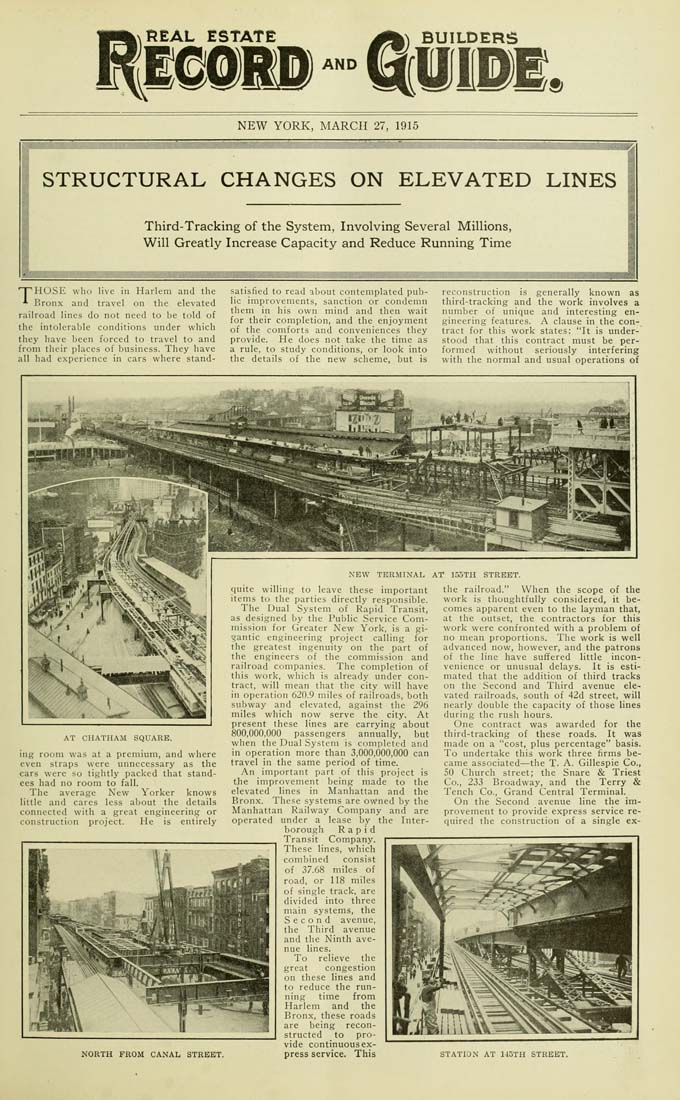Columbia University Libraries Digital Collections: The Real Estate Record
Use your browser's Print function to print these pages.
Real estate record and builders' guide: [v. 95, no. 2454: Articles]: March 27, 1915

Text version:
Please note: this text may be incomplete. For more information about this OCR, view About OCR text.
REAL ESTATE AND %) BUILDERS NEW YORK, MARCH 27, 1915 Hiiiiiiiii STRUCTURAL CHANGES ON ELEVATED LINES Third-Tracking of the System, Involving Several Millions, Will Greatly Increase Capacity and Reduce Running Time ■"P Ht ).Si'^ will! live in Harlem and the ^ Bronx and travel on the elevated railroad lines do not need to be told of the intolerable conditions under which they have been forced to travel to and froni their places of business. They have all had experience in cars where stand- satisiied to read about contemplated pub¬ lic improvements, sanction or condemn them in his own mind and then wait for their completion, and the enjoyment of the comforts and conveniences they provide. He does not take the time as a rule, to study conditions, or look into the details of the new scheme, but is reconstruction is generally known as third-tracking and the work involves a number of unique and interesting en¬ gineering features. A clause in the con¬ tract for this work states: "It is under¬ stood that this contract must be per¬ formed without seriously interfering with the normal and usual operations of AT CHATHAM SQUARE. ing room was at a premium, and where even straps were unnecessary as the cars were so tightly packed that stand¬ ees had no room to fall. The average New Yorker knows little and cares less about the details connected with a great engineering or construction project. He is entirely NORTH FROM CANAL STREET, quite willing to leave these important items to the parties directly responsible. The Dual System of Rapid Transit, as^ designed by the Public Service Com¬ mission for Greater New York, is a gi¬ gantic engineering project calling for the greatest ingenuity on the part of the engineers of the commission and railroad companies. The completion of this work, which is already under con¬ tract, will mean that the city will have in operation 620.9 miles of railroads, both subway and elevated, against the 296 miles which now serve the city. At present these lines are carrying about 800,000,000 passengers annually, but when the Dual System is completed and in operation more than 3,000,000,000 can travel in the same period of time. An important part of this project is the improvement being made to the elevated lines in Manhattan and the Bronx. These systems are owned by the Manliattan Railway Company and are operated under a lease by the Inter¬ borough Rapid Transit Company. These lines, which combined consist of 37.68 miles of road, or 118 miles of single track, are divided into three main systems, the Second aventie, the Third avenue and the Ninth ave¬ nue lines. To relieve the great congestion on these lines and to reduce the run¬ ning time from Harlem and the Bronx, these roads are being recon¬ structed to pro¬ vide continuousex- press service. This the railroad." When the scope of the work is thoughtfully considered, it be¬ comes apparent even to the layman that, at the outset, the contractors for this work were confronted with a problem of no mean proportions. The work is well advanced now, however, and the patrons of the line have suffered little incon¬ venience or unusual delays. It is esti¬ mated that the addition of third tracks on the Second and Third avenue ele¬ vated railroads, south of 42d street, will nearly double the capacity of those lines during the rush hours. One contract was awarded for the third-tracking of these roads. It was made on a "cost, plus percentage" basis. To undertake this work three tirms be¬ came associated—the T. A. Gillespie Co., 50 Church street; the Snare & Triest Co., 233 Broadway, and the Terry & Tench Co., Grand Central Terminal. On the Second avenue line the im¬ provement to provide express service re¬ quired the construction of a single ex- STATION AT l4oTH STREET.